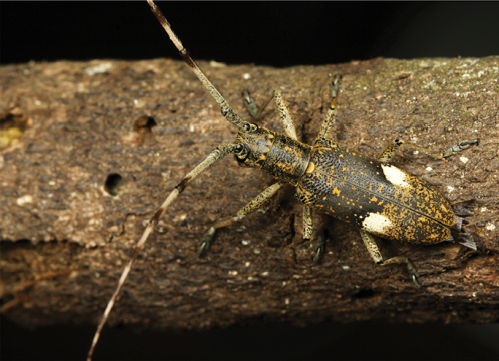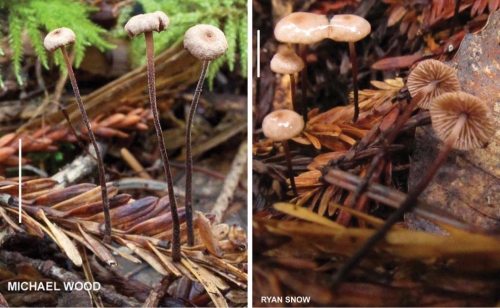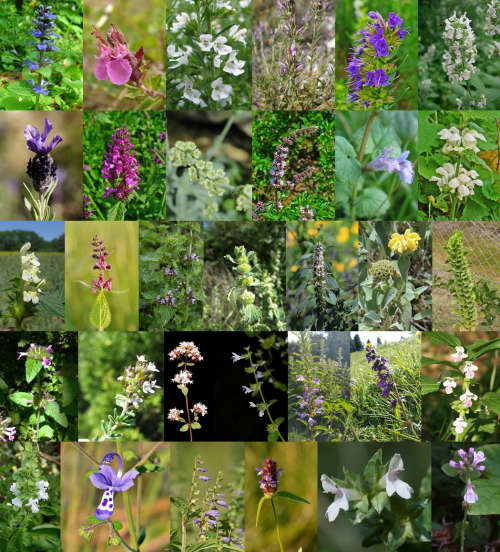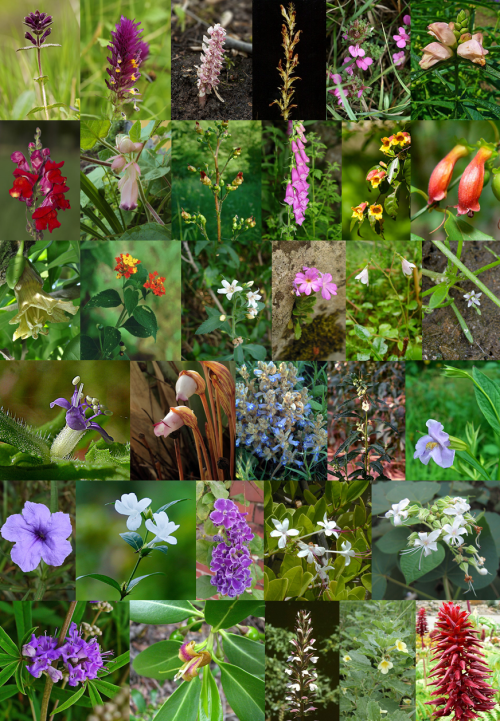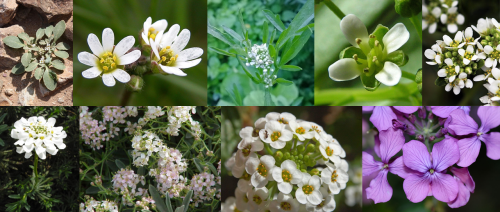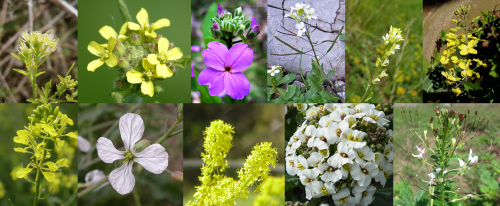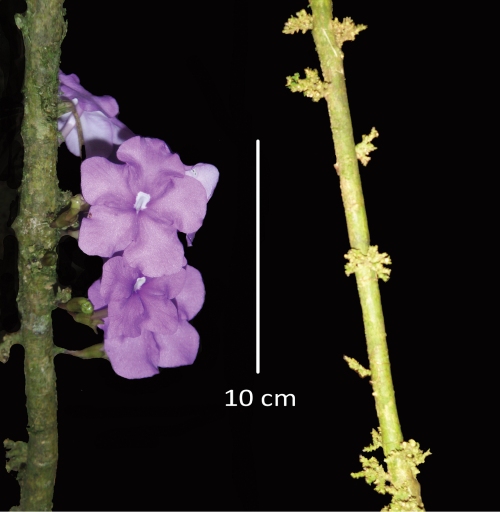by Piter Kehoma Boll
Here is a list of species described from February 21 to February 28. It certainly does not include all described species. Most information comes from the journals Mycokeys, Phytokeys, Zookeys, Phytotaxa, Zootaxa, International Journal of Systematic and Evolutionary Microbiology, and Systematic and Applied Microbiology, as well as journals restricted to certain taxa.
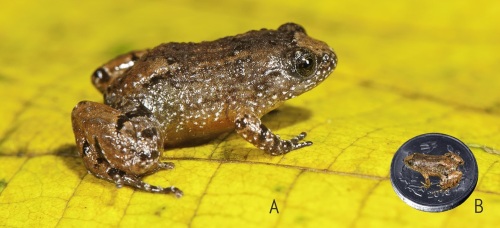
Nyctibatrachus manalari is a new tiny frog described in the past 8 daysdescribed in the past 8 days.
Bacteria
- 6 new actinobacteria: Aeromicrobium choanae sp. nov.; Krasilnikoviella muralis gen. et sp. nov.; Micromonospora parathelypteridis sp. nov.; Rhodococcus sovatensis sp. nov.; Flexivirga oryzae sp. nov.; Micromonospora terminaliae sp. nov.;
- 5 new firmicutes: Bacillus capparidis sp. nov.; Streptococcus himalayaensis sp. nov.; Desulfonatronospira sulfatiphila, Desulfitispora elongata spp. nov.; Thermoanaerobacterium butyriciformans sp. nov.;
- 2 new bacterioidetes: Algoriphagus iocasae sp. nov.; Labilibacter auranticus sp. nov.;
- 12 new proteobacteria: Aliidongia dinghuensis gen. nov., sp. nov.; Novosphingobium guangzhouense sp. nov.; Aureimonas glaciei sp. nov.; Racemicystis persica sp. nov.; Altererythrobacter soli sp. nov.; Saccharedens versatilis sp. nov.; Methylobacillus methanolivorans sp. nov.; Alteromonas lipolytica sp. nov.; Marinobacter salinus sp. nov.; Oryzomicrobium terrae sp. nov.; Neptuniibacter pectaenicola and N. marinus spp. nov.;
- 1 new gemmatimonadete: Gemmatimonas phototropica sp. nov.;
- 1 new spirochaete: Pleomorphochaeta caudata sp. nov.;
Plants
- 13 new flowering plants: Garcinia gamblei, sp. nov.; Psidium grazielae sp. nov.; Aspidistra zhenganensis sp. nov.; Asparagus azerbaijanensis sp. nov.; Lysipomia petrosa sp. nov.; Chlorophytum mamillatum sp. nov.; Allium iatrouinum and A. pycnotrichum spp. nov.; Epidryos matheusii, sp. nov.; Cinchona anderssonii, sp. nov.; Reissantia sp. nov.; Trifolium kurdistanicum, sp. nov.; Garcinia hopii sp. nov.;
- 1 new green alga: Cladophora subtilissima sp. nov.;
- 2 new red algae: Wilsonosiphonia fujiae sp. nov. and W. indica sp. nov.;
Fungi
- 10 new ascomycetes: Nigelia aurantiaca, Metarhizium chaiyaphumense, M. kalasinense, M. prachinense, M. samlanense, and M. takense spp. nov.; Pyrenochaetopsis tabarestanensis sp. nov.; Bryoria barbata, B. fruticulosa, B. wuii and B. yunnana spp. nov.;
- 1 new basidiomycete: Crepidotus lutescens sp. nov.;
Sponges
- 2 new hexactinellids: Ferrea sp. nov., Tretodictyum sp. nov.;
- 1 new demosponge: Baikalospongia abyssalis sp. nov.;
Annelids
- 7 new polychaetes: Syllis boggemanni, n. sp.; S. joaoi, n. sp.; S. karlae, n. sp.; S. marceloi, n. sp.; Syllis albae sp. nov., Syllis tamarae sp. nov. and Syllis tripantu sp. nov.;
Nematods
- 4 new species: Sabatieria megadena sp. n., Pararaeolaimus tetradenus sp. n., Southerniella parasimplex sp. n., and Diplopeltula cuspidiboja sp. n.;
Arachnids
- 10 new mites: Pachylaelaps abludens sp. nov., P. bergomensis sp. nov., P. marcovallei sp. nov., and P. pantinii sp. nov.; Propeaciota genusetosis n. gen. and n. sp. and Spinaephyes alnus n. gen. and n. sp.; Amazoniaseius imparisetosus n. sp., n. g.; Davisella trevisani n. sp. and Tetra theobromae n. sp.; Origmatrachys peruensis sp. nov.;
- 5 new spiders: Amazoonops almeirim sp. nov., A. cachimbo sp. nov., A. caxiuana sp. nov., A. juruti sp. nov. and A. ducke sp. nov.;
Crustaceans
- 1 new crab: Himalayapotamon garhwalense n. sp.;
Hexapods
- 22 new beetles: Chlamisus corollinotatus sp. nov., C. lycocephalus sp. nov. and C. varipennatus sp. nov.; Afrotarus fadli sp. n. and A. soudaensis sp. n.; Atrocrates kandai sp. nov., A. smithi sp. nov. and Schelodontes baviaanskloofensis sp. nov.; Aphrodisium lingafelteri sp. nov., Mimochelidonium vietnamicum sp. nov., and Polyzonus (Striatopolyzonus) tonkinensis sp. nov.; Phaenostoma tupiniquim sp. nov.; Tarphius relictus sp. nov., Tarphius furtadoi sp. nov., Tarphius gabrielae sp. nov. and Tarphius floresensis sp. nov.; Smicronyx jordanicus and S. longitarsis spp. nov.; Bidessodes chlorus sp. n., B. erythros sp. n., B. leukus sp. n., and B. melas sp. n.;
- 45 new flies: Liriomyza agrios, L. albispina, L. anatolis, L. aphila, L. apilaca, L. aquapolis, L. arenarium, L. atrassimilis, L. bicolumbis, L. charada, L. cracentis, L. elevaster, L. emaciata, L. fumeola, L. gibsoni, L. griffithsi, L. hilairensis, L. limopsis, L. mesocanadensis, L. pilicornis, L. pistilla, L. rigaudensis, L. taraxanox, L. taraxanuda, L. tryssos. spp. nov.; Manota aligera sp. n., M. aristoseta sp. n., M. calva sp. n., M. ciliata sp. n., M. exigua sp. n., M. digitata sp. n., M. flabellata sp. n., M. iquitosensis sp. n., M. limulata sp. n., M. micella sp. n., M. minutula sp. n., M. nuda sp. n., M. parvula sp. n., M. pauloides sp. n., M. pustulosa sp. n. and M. serrulata sp. n.; Anopheles (Anopheles) prachongae, sp. nov.; Simulium (Gomphostilbia) lemborense sp. nov.; Conchapelopia brachiata sp. n.; Tipula (Vestiplex) leigongshanensis sp. n. and T. (V.) maoershanensis sp. n.;
- 7 new damselflies: Argia calverti n. sp., Argia carolus n. sp., Argia elongata n. sp., Argia haberi n. sp., Argia schorri n. sp., Argia rudolphi n. sp. and Argia schneideri n. sp.;
- 13 new cockroaches: Aptera brindlei sp.nov., Rhabdoblattella alexeevi sp.nov., R. euptera sp.nov., Morphna indica sp.nov., Placoblatta beybienkoi sp.nov., Morphnasrilankensis sp.nov.; Ctenoneura bawangensis sp. nov., Ctenoneura delicata sp. nov., Ctenoneura elongata sp. nov., Ctenoneura heixuanfeng sp. nov., Ctenoneura helicata sp. nov., Ctenoneura papillaris sp. nov. and Ctenoneura qiuae sp. nov.;
- 3 new thrips: Paroxythrips podocarpi, sp. nov.; Stephanothrips austrinus sp. n. and Urothrips calvus sp. n.;
- 1 new moth: Zebraodes lucidalis n. sp.;
- 11 new caddisflies: Oxyethira calori sp. nov., O. diplospissa sp. nov., O. guariba sp. nov., O. iannuzzae sp. nov., O. maranhensis sp. nov., O. rafaeli sp. nov., O. gracilianoi sp. nov., O. retrosa sp. nov., O. septentrionalis sp. nov., O. singularis sp. nov., O. una sp. nov.;
- 6 new true bugs: Cromata flavida sp. nov., Lincus curvatus sp. nov., Ocellatocoris longirostris sp. nov., and Xynocoris ecuadorensis sp. nov.; Megatibicen harenosus sp. n.; Brachycoris tralucidus sp. nov.;
- 6 new wasps: Acanthocaudus bicolor sp. nov.; Megaprosternum cleonarovorum sp. nov.; Anaphes quinquearticulatus sp. n., Paranaphoidea (Idiocentrus) africana sp. n. and Allanagrus occidentalis sp. n.; Poropoea africana sp. n.;
- 1 new cricket: Leleja khao sp. n.;
- 2 new springtails: Folsomia minorae sp. n. and F. australica sp. n.;
Cartilaginous fishes
- 1 new lanternshark: Etmopterus lailae sp. nov.;
Ray-finned fishes
- 2 new cyprinodontiforms: Melanorivulus spp. nov.;
- 1 new perciform: Pseudocrenilabrus pyrrhocaudalis sp. nov.;
Lissamphibians
- 10 new frogs: Chiasmocleis migueli sp. nov., C. veracruz sp. nov., C. altomontana sp. nov.; Nyctibatrachus athirappillyensis sp. nov., Nyctibatrachus manalari sp. nov., Nyctibatrachus pulivijayani sp. nov., Nyctibatrachus radcliffei sp. nov., Nyctibatrachus robinmoorei sp. nov., Nyctibatrachus sabarimalai sp. nov. and Nyctibatrachus webilla sp. nov.;
Mammals
- 1 new bat: Neoromicia stanleyi sp. nov.;
- 1 new shrew: Sorex mccarthyi sp. nov.;

